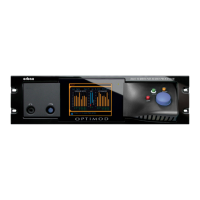OPTIMOD MAINTENANCE
4-13
D) LOCATE to diagnostic screen 3 at the unit or, after connecting via PC Remote,
open the PC diagnostic dialog box. Verify that the last line reads “485 loop-
back ok.”
• If the loopback fails, no text will be displayed—there is no “error message.”
• The line above the loopback shows the current Dialnorm value received.
Valid values are 11-31. 00 indicates that no Dialnorm is being received.
11. Optional tests.
A) GPI (Remote Interface) inputs: You can test each GPI input for functionality in
the obvious way, by programming a function for it and then verifying that
the function executes when you activate the input. To connect to the GPI in-
puts, see step 5 on page 2-3. To program a GPI input, see Remote Control In-
terface Programming on page 2-54.
B) Tally outputs:
a) Connect them according to step 6 on page 2-3.
b) Program them for each of the conditions listed in
step (22.B) on page 2-38
and verify that they respond accordingly. AESxx input errors can be tested
most
simply by disconnecting the AES3id signal from the input
programmed to trigger the tally.
This test also verifies the 8685’s Silence Sense functionality (see step 21 on
page 2-37).
C) RS-232 Port: You can test the RS-232 for functionality by verifying that you
can connect to a PC through a null modem cable. See Networking and Remote
Control on page 2-56 (in particular, step 2 on page 2-57).
12. Test Digital I/O and Sync for Input/Output 1/2 (Lf/Rf).
A) Recall the A
UDIT33 Setup. This uses the 2.0 processing chain as a test tone gen-
erator to test the surround channels.
B) Using a 75Ω BNC/BNC jumper cable, the 8685’s O
UTPUT 5/6 BNC connector to
its I
NPUT 1/2 BNC connector and verify that the 1/2 indicator on the 8685’s
front panel turns yellow, indicating that the 8685’s
INPUT 1/2 AES3id receiver
has locked to the signal emitted from O
UTPUT 11/12.
C) Connect the digital analyzer to the 8685’s O
UTPUT1/2 BNC connector and verify
that the THD+N is below –100 dBfs and that the sample rate is 48 kHz, as
locked to the input sample rate.
D) A
UDIT33 emits its test signal at a 48 kHz sample rate. To test 32 kHz, 44.1 kHz,
88.2 kHz, and 96 kHz sample rates, recall
AUDIT34, AUDIT35, AUDIT36, and
A
UDIT37 in turn. Use the AES3id analyzer to do the following for each sample
rate:
a) Measure the THD+N and verify that it is below –100 dBfs (0.001%).
b) Listen to the AES3id analyzer’s decoded analog output and verify that the
output sounds clean and glitch-free.

